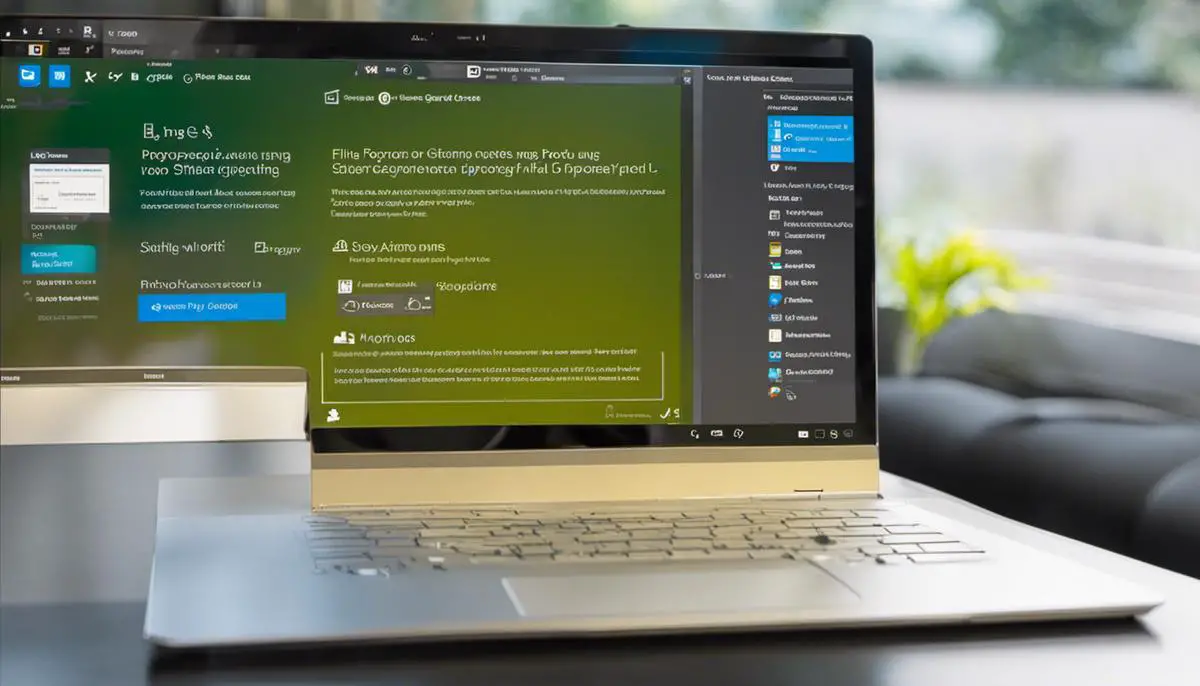Mastering File Sharing on Windows 10
Discover essential tips for File Sharing on Windows 10. Learn how to share files seamlessly and securely with our easy guide.
In today’s interconnected digital world, the need to share files across various devices has become more crucial than ever.
The concept of file sharing – empowering users with the ability to distribute selected files, documents, images, or folders to other network users – has numerous benefits including enhanced productivity, efficient communication, and increased collaboration among teams.
In this context, Windows 10, a popular operating system by Microsoft, comes integrated with advanced file-sharing capabilities.
This guide will shed light on understanding the fundamentals of file sharing, configuring Windows 10 to enable file sharing, and the practical steps to share files and folders effectively.
Understanding File Sharing
Essentials of File Sharing on Windows 10: What You Need to Know
File sharing remains the lifeline of the interconnected technology world, enabling efficient communication and collaboration. The tech enthusiast’s nirvana lies directly within being able to share media, documents, or collaborate effectively on a project via the Windows 10 operating system. But before diving headfirst into the boundless world of file sharing, some quintessential know-how is required.
Access Control and Permissions
First and foremost, understanding access control and permissions is crucial. Windows 10 regulates who can access specific files or directories. Permissions determine the type of access users have, such as ‘read’, ‘write’, or ‘execute’. Understanding these permissions is the first step to controlling who has access to your files.
Workgroup Vs. Homegroup
Windows 10 does not support HomeGroup anymore. Instead, it leverages the standard ‘Workgroup’ functionality. Each computer in a Workgroup can access shared files and folders of other computers in the group, creating a peer-to-peer network. Knowing the difference and limitations is crucial before leaping into file sharing.
Simple File Sharing and Advanced Sharing
Another essential aspect is differentiating between Simple File Sharing and Advanced Sharing. Simple File Sharing is the easiest way to share files between two computers connected to the same network. In contrast, Advanced Sharing offers more control over permissions and is suitable for sharing files over larger networks.
Networking Protocols
Lastly, a basic understanding of networking protocols such as TCP/IP, NETBIOS is a must-have under your belt as they govern how data is shared over a network.
File and Printer Sharing Option
The File and Printer Sharing option allows you to share your printer with other devices on the same network. Having knowledge about this feature will let you print documents from any device connected to your home or office network.
Public Folder
Windows 10 has a built-in public folder on each drive that all users on the same computer or network can access. Learning how to manage and control access to these folders is vital.
Shared Experiences Feature in Windows 10
The Shared Experiences feature in Windows 10 lets you quickly and easily share files, web links, and apps with other devices connected to your Microsoft account.
In conclusion, understanding these basic elements of file sharing in Windows 10 makes the process seamless, secure, and efficient. Remember, the more adept you become at these functionalities, the more productive and collaborative your work can be—embrace these basic facets as a stepping stone to becoming a Windows 10 file sharing maestro.

Configuring Windows 10 for File Sharing
Streamlining File Sharing Experience on Windows 10
Step into the world of seamless connectivity and unified accessibility with Windows 10 file sharing options. Let your files travel from one system to another without breaking a sweat. This guide aims to navigate you through the tidy process of setting up your Windows 10 for effortless file sharing. Let’s jump right into everything you need to know to make this happen.
Start by setting up your Network Profile. This feature guides your system in deciding the levels of security it must adopt while connecting to a new network. To change the Network Profile, head to ‘Settings,’ then proceed to ‘Network and Internet,’ and finally select ‘Ethernet’ or ‘Wi-Fi’ based on your connection type. The Network Profile can be switched between ‘Public’ and ‘Private.’ For file sharing purposes, ‘Private’ would be the ideal setting.
Now, sit tight as it’s time to master File Sharing settings. To achieve this, proceed to the ‘Control Panel,’ select ‘Network and Sharing Centre’ then, ‘Advanced Sharing Settings.’ Under ‘Private’ (or ‘Guest or Public’ if required), choose ‘Turn on File and Printer Sharing.’ Remember, the luxury of automation requires precise details!
Don’t worry, you’re halfway there. Now it’s time to share individual folders. Find the folder that you want to share, right-click on it, and select ‘Properties.’ Under the ‘Sharing’ tab, click on ‘Share.’ Add the user or group you want to share with, and specify the level of access they have – read, write, or both. Celebrate your success – you’ve set up a shared folder!
The crux of the guide is the sharing through ‘Windows Settings.’ Go to ‘Settings,’ then ‘Network and Internet,’ and select ‘Sharing Options.’ Enable ‘Turn on Network Discovery,’ ensuring that the ‘Turn on automatic setup of network connected devices’ checkbox is checked. This allows your system to see and be seen by other devices.
For file sharing access, Windows 10 employs a simple username and password system. Your sharing partner will need your system’s username and password. You can also create a new account specifically for sharing. To do this, venture into ‘Control Panel’, select ‘User Accounts,’ followed by ‘Manage another account,’ and finally ‘Add a new user in PC settings.’ Create the account and set a password.
And there you have it, a streamlined process of using the sophisticated machinery that is Windows 10 for your file sharing needs. Don’t let the numerous steps deter you! The possibilities of fast, seamless connections are worth it. Remember, keep exploring, keep automating. Enjoy your newfound power of connectivity!

Sharing Files and Folders on Windows 10
Commencing the process for sharing files and folders in Windows 10 entails a series of steps that continue from setting up network profiles and configuring file sharing settings to creating a new account for sharing. These methods, while detailed, are very much accessible and serve a beneficial purpose in facilitating smooth communication and integration between devices.
To share an individual file or folder, begin by locating the said file or folder through the windows explorer. After highlighting the file or folder, right-click and go directly into ‘Properties.’ This is where you’ll find the ‘Sharing’ tab. Clicking this tab will manifest two principal options – network file and folder sharing and advanced sharing.
For quick and simplified sharing, choose ‘Network file and folder sharing.’ Then, by simply clicking ‘share,’ Windows will generate a link that you can distribute to other users so they can easily access the shared item.
To facilitate sharing through ‘Windows Settings,’ navigate to the ‘System’ option from the ‘Settings’ menu. From there, select ‘Shared experiences’ to arrive at numerous sharing possibilities. Here you can opt to share across devices, broadcast user activities, or share between devices using Bluetooth or WIFI.
For a more secure file-sharing process, adopting a username and password authentication mechanism is recommended.
It begins with setting up a local account on your Windows 10 system. Under ‘Settings,’ visit ‘Accounts,’ then ‘Family and other users’ to find the ‘Add someone else to this PC’ option.
Follow the prompts to create a new account, assigning it a username and password. Others can then access shared files only if they authenticate using these login credentials.
Need to share multiple files or restrict access without setting up an entire account? You can directly share the folder containing the files. Just navigate to the folder’s ‘Properties,’ then to ‘Sharing,’ and finally to ‘Advanced Sharing.’ Check the box for ‘Share this folder.’ Assign a name to the file share, and if users need to modify the files, enable ‘Allow others to make and delete files in this share.’ For restricted access, go into ‘Permissions’ and customize the permissions as needed.
In summary, Windows 10 has made the file and folder sharing process diverse and customizable to meet individual needs and ensure ease of use.
Whether you’re looking for a straightforward solution or a more complex, access-restricted setup, there’s a method to accommodate it.
Remember, a properly configured sharing setup leads not only to improved productivity but also to a secure and efficient sharing environment.
Keep in mind that while these easy-to-follow instructions make the process seem simple, appropriate care must still be taken. A file shared without proper permissions may expose sensitive information.
Therefore, never skip critical steps like establishing a username-password-based security system or setting permissions to maintain file integrity and protect data. And with this, you’re ready to make file sharing a smooth, integrated part of your Windows 10 experience.

With adequate knowledge and understanding of file sharing as well as gaining proficiency in configuring and executing file sharing on Windows 10, users can harness the maximum potential of this powerful feature.
File sharing improves collaboration, saves time, and increases overall productivity. One just needs to follow the mentioned steps cautiously to share files or folders.
Ultimately, the objective is to streamline the process, enhance cooperation, and ensure seamless access to relevant files or folders across all network users.
Embracing these techniques will undeniably lead you towards an enriched user experience with Windows 10.






